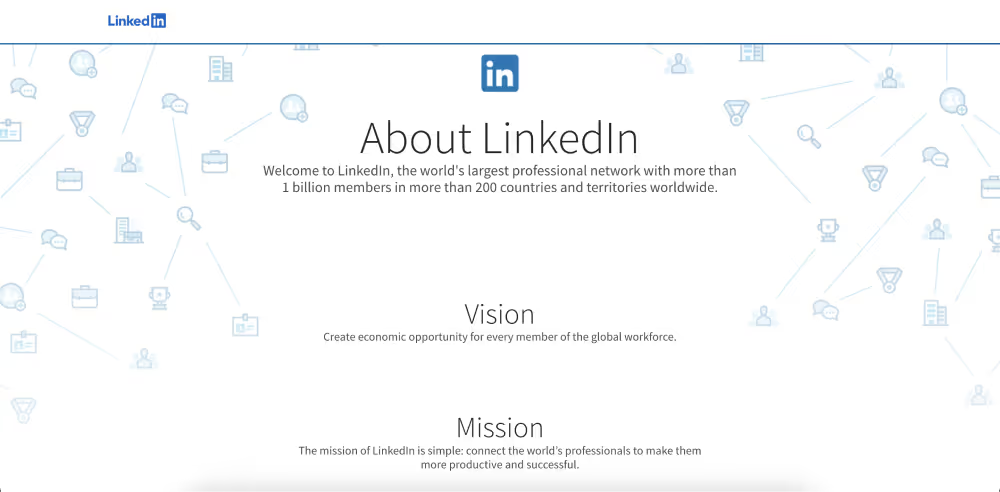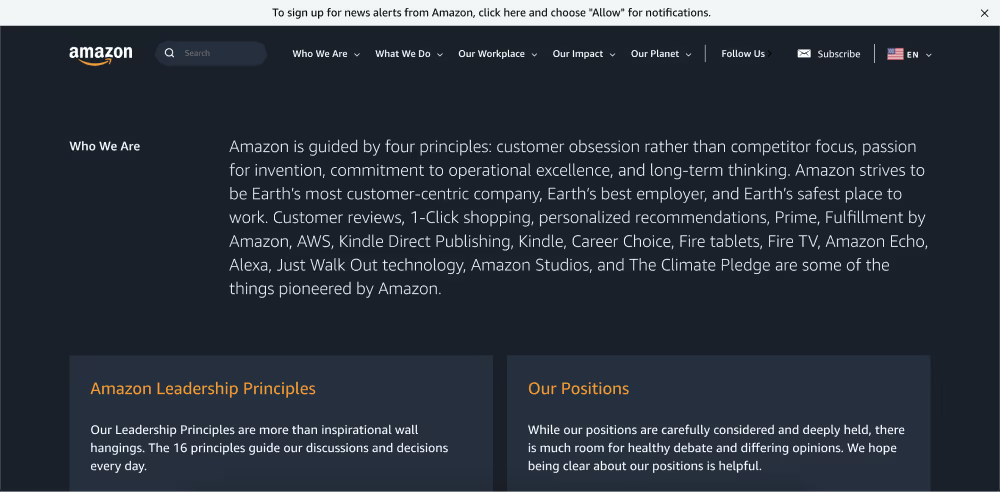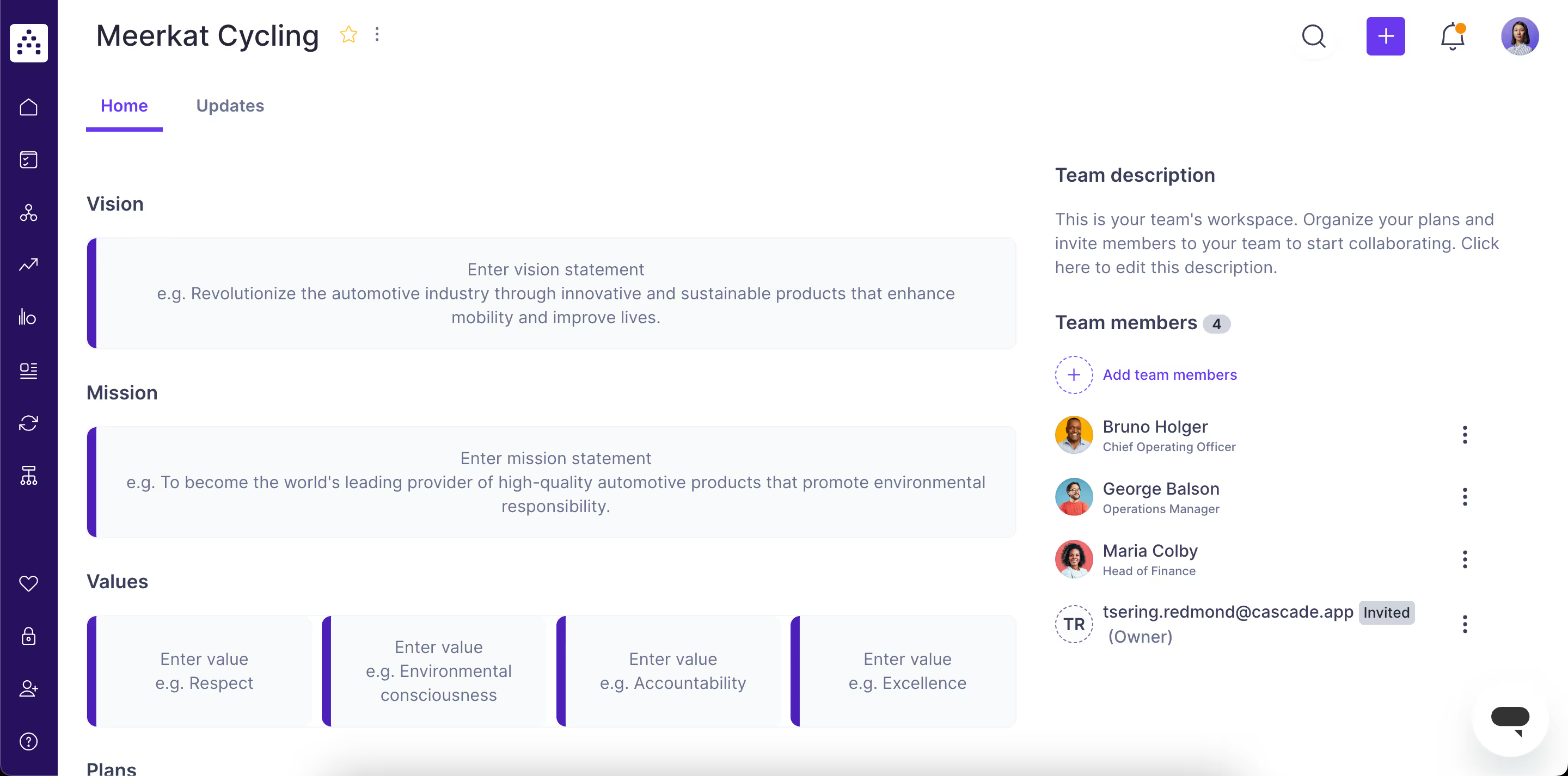.avif)
In this comprehensive guide, we'll cover the basics of a vision statement—what is it, why is it important, what a good one looks like—and provide you with a bullet-proof step-by-step formula and tips on how to write a vision statement. We will also provide inspiring vision statement examples from top organizations.
🎁As a bonus, you can download our free Vision Statement Tookit with all the resources you need to create a great business vision statement that rallies your whole organization towards achieving your ultimate goal.
Here's what you will discover inside:
- What Is A Vision Statement?
- Why Is A Vision Statement Important For Company Goals?
- Vision Statement Vs Mission Statement: What's The Difference?
- Key Characteristics Of Great Vision Statements
- Helpful Tips For Writing Your Own Vision Statement
- Fail-proof Formula: How To Write A Vision Statement In 4 Simple Steps
- What To Avoid When Writing A Vision Statement
- Bad Vision Statement Examples (And Why)
- Great Vision Statement Examples For Inspiration
- How To Effectively Communicate Your Company Vision?
- Turn Your Vision Into A Strategic Advantage
What Is A Vision Statement?
.avif)
A company vision statement describes the desired future state of the organization in the long term—generally within a 5 to 10-year timeframe—and guides the direction of the business's efforts. It serves as a guiding framework for the business's strategic efforts being a critical component of a highly effective business strategic plan.
🎥 If you’re more of a visual learner, watch our video on how to write a vision statement for a straightforward, step-by-step guide:
Why Is A Vision Statement Important For Company Goals?
By clearly defining the long-term aspirations of your business, a vision statement outlines a roadmap for the future. It guides decision-making, aligns efforts, and inspires stakeholders to work towards common goals.
Here’s a detailed look at the critical functions of a vision statement:
Drives strategic decision-making
A well-defined vision statement acts as a filter for strategic initiatives, ensuring that every decision aligns with the company's ultimate goals. This focused approach optimizes resource allocation and prevents distractions.
Aligns teams and fosters unity
A shared vision statement creates a sense of purpose and belonging among employees enabling organization-wide alignment. When everyone understands the company's direction, collaboration improves, and teams become more effective.
Enhances organizational culture
A strong vision statement contributes to a positive company culture by defining shared company values and aspirations. It inspires employees to go above and beyond, fostering a sense of pride and commitment.
Influences external stakeholders
A clear and compelling vision statement attracts investors, customers, and partners. It communicates the company's ambition and potential, building trust and credibility.
As you can see, a company’s vision statement isn't just a nice-to-have; it's a critical component of every business plan and strategy discussion. Including it in the strategic planning process ensures that the organization and its departments remain aligned with the vision and avoid getting sidetracked.
Vision Statement Vs Mission Statement: What's The Difference?
.avif)
The most common mistake we see across the internet and with our customers is that most people do not understand the difference between a company's mission and vision statements. Mistaking one for another can prevent an organization from reaching its full potential.
While we covered this a bit more in-depth in this article, here's a short recap:
- A vision statement describes a long-term, idealistic state of your company’s FUTURE.
- A mission statement describes a roadmap to a specific destination (your VISION) that explains how will you achieve it.
Let’s see an example from LinkedIn:
- Vision statement: To create economic opportunity for every member of the global workforce.
- Mission statement: To connect the world's professionals to make them more productive and successful.
LinkedIn's mission and vision statements clearly articulate their long-term goals and the practical steps they are taking to achieve those goals, serving as a best practice for distinguishing between the two.

💡Tip from our Cascade strategy experts: If you're in doubt about what is a vision statement and what is a mission statement, do this simple test with two questions.
- What do they want to achieve? To create the most compelling car company of the 21st century… (vision statement)
- How? … by driving the world's transition to electric vehicles (mission statement)
Key Characteristics Of Great Vision Statements
Crafting your company’s vision statement involves more than just jotting down a few inspiring sentences and sharing them with your teams. A well-constructed vision statement should have several key characteristics to effectively guide and inspire your organization.
Evocative and inspiring
Powerful vision statements stir emotions and ignite imagination. They tap into the human spirit, creating a sense of purpose and excitement that resonates with employees at every level. Think memorable and inspiring—something that leaves a lasting impression.
Customer-centric
An effective vision statement puts the customer first, showing a deep understanding of their needs, desires, and challenges. It should clearly articulate how your organization will create value for customers and build lasting relationships.
Future-oriented
Your vision statement should look beyond the present to imagine a better future. It should challenge the status quo and inspire innovation, providing a clear path toward progress and growth for the entire organization.
Differentiating and unique
A great vision statement sets your organization apart from the competition. It should highlight what makes your company unique, showcasing your value proposition and competitive advantages. What makes your company special and different? Make sure to include that in your vision.
Action-oriented
Vision statements should be more than just a statement of intent; they should inspire action and provide clear direction and motivation for employees, empowering them to contribute to actually achieving that vision. Remember, even if your vision is the best one yet, without effective execution, it remains just words on paper. It's the daily actions, decisions, and strategies driven by that vision that turn it into reality.
By incorporating these characteristics, your vision statement will become a powerful tool for driving growth and success.
📹 Watch this episode of The Ultimate Strategy Podcast for insights from Miriam Lesa, Devina Patel, and Laura Blackmore on building a compelling vision that aligns with your organization’s purpose and inspires action.
Helpful Tips For Writing Your Own Vision Statement
Keep in mind that vision creation doesn't begin with sitting behind a desk and writing black on white. Reach out to your stakeholders and team members who will play a role in realizing the company's vision. Organize a workshop, or more if necessary, to brainstorm ideas and gather their feedback.
Our free Vision Statement Toolkit includes a template and workbook designed to guide you through brainstorming exercises and streamline the entire vision creation process.
As a result, including other stakeholders in the vision-creation process will not only yield ideas but also get buy-in from the beginning since it will be their vision too.
Here are 8 tips to help you write an inspiring vision statement:
.avif)
Tip #1 Keep it short
Your vision statement should be punchy and easy to remember. Aim for a maximum of two sentences to ensure it is concise and impactful.
Tip #2 Make it specific
Tailor your vision statement to your business and describe a unique outcome that only your organization can provide. This specificity sets your vision apart and makes it more relatable.
Tip #3 Write in the present tense
Craft your vision statement in the present tense to create a sense of immediacy and relevance. This approach makes the vision feel more attainable and actionable.
Tip #4 Avoid ambiguity
Steer clear of words that are open to interpretation. For instance, stating that you will maximize shareholder return in 2022 is vague unless you specify what that means. Be precise in your language to avoid misunderstandings.
Tip #5 Simplicity is key
There is a tendency to overcomplicate vision statements, but clarity is essential. Make your vision clear enough for both internal and external audiences to understand. Avoid jargon, metaphors, and business buzzwords.
Tip #6 Be ambitious yet realistic
Your vision statement should be ambitious enough to inspire excitement, but not so unrealistic that it seems impossible to achieve. Find a balance that motivates without discouraging.
Tip #7 Allow for evolution
A vision statement should evolve with your business. When brainstorming your future vision, consider a five-year timeframe. This period is long enough to set an ambitious goal but short enough to maintain focus and commitment.
Tip #8 Align with core values
Ensure your vision statement aligns with your company's core values. Once you have established your company values, review your vision to confirm that they are in sync. This alignment reinforces your organization's identity and purpose.
💡 If anything, you should memorize these 4 words before you go into crafting your own vision statement: Short, Specific, Simple, and Ambitious
Fail-proof Formula: How To Write A Vision Statement In 4 Simple Steps
There are hundreds of articles out there that give examples of good and bad vision statements. There are also plenty of articles that give a high-level overview of what to consider when creating your own.
However, what we noticed was lacking was a concrete step-by-step process to go through to help you create one. As such, we've outlined a process that we often use with our customers that might work for you too.
There are plenty of great vision statements out there that will not conform to the process below. But if you're struggling or just need a place to start, then hopefully this will help.
.avif)
Step 1: Define what you do as an outcome
Start by being exceptionally clear about what it is your organization actually does. Be careful to remain 'outcome focused' rather than 'output focused'.
For example, Microsoft famously had a vision statement to “Put a Microsoft-powered computer on every desk in the world” (slightly paraphrased).
Strictly speaking, what Microsoft 'does' is make computer software, but for the purposes of their vision, they looked forward to the actual outcome of this process - i.e. computers on desks.
Let's look at some other vision statement examples:
- A bakery makes bread. But the outcome is consumers enjoying that bread.
- A consulting company gives advice. But the outcome is the success of others based on that advice.
- A government department does...lots of things. But the outcome is better lives for the citizens they serve.
Whilst this process may seem obvious, you would be surprised by how rarely organizations actually go through this process in a formal, written way.
Doing so will take you a long way towards creating your vision statement—BUT it's not enough alone. If it was, all bakeries, for example, would have the same vision statement which is hardly inspiring!
💡TIP: If you are not sure where your organization wants to be in the future, you can use different tools, like SWOT or SOAR analysis, that will help you formulate your vision and future-oriented goals.
Step 2: Define what unique twist your organization brings to the above outcome
Very few products or services these days are truly new—most are more like reinventions of something that exists already, but with a different approach, focus, or spin.
At some point in your organization's lifespan, someone will have believed that the reason that THIS organization would be successful where others have failed, was because of.........something.
You need to define that something!
Let's take our bakery example. So far, our vision statement looks pretty generic, along the lines of customers enjoying our bread. But why will they enjoy our bread more than the bread from the place next door?
Is it because we use centuries-old traditions passed through generations of our family? Because we only use premium grade locally sourced ingredients? Whatever your unique selling point is, let it shine through in your vision statement.
Step 3: Apply some high-level quantification
Ironically, a common problem with a vision statement is that it's too visionary. With no possible end in sight (or a totally unrealistic one) the initial inspiration derived from a solid vision statement can quickly turn to frustration or even cynicism among employees and customers.
That said, this doesn't mean you should put numbers or any financial metrics in your vision statement—this will come later in your planning process.
However, you still want to add some high-level quantification to make it achievable.
Sticking with our bakery example, we might want to refine our target audience to 'every customer who walks through the door'. That's fine, or maybe we want to be bolder: 'every customer within walking distance of a store'.
The quantification we apply could also be industry-specific. If you're a B2B, are you shooting for small businesses or multinationals, for example?
Step 4: Add relatable, human, 'real world' aspects
Your vision statement by this point should be getting pretty close to finished. But one final trick you can apply to help make it even more memorable is to add a real-life aspect.
This will allow people to conjure up a solid mental image to associate with your vision statement.
Let's look at two different vision statement examples. Which of the following do you think is likely to be more memorable?
a) To have every working person in the world using Microsoft product
or...
b) A Microsoft-powered computer on every desk
We would argue that (b) is more memorable because as you read this, you're actually visualizing a computer sitting on a wooden desk in a room.
There's nothing wrong with (a), but it's highly conceptual and thus difficult to transform into a mental picture. Let's look at another example:
"Ensure that every customer who leaves our store does so smiling."
Here, using the word 'smiling' instead of 'happy' is powerful because it conjures a mental image of a person smiling.
It won't always be possible to bring this level of tangibility to a vision statement, but if it is, we strongly encourage you to do so.
Putting it all together
Following our 4-step process, the final vision statement of our bakery would look something like this:
Producing and selling locally sourced cakes and pies that are so delicious and satisfying, that every customer who leaves our store does so with a smile.
If we deconstruct it into the various steps, we can see each at work as follows:
Step 1 - The output
Step 2 - The twist
Step 3 - The quantification
Step 4 - The human connection
Even if yours doesn't look like this at the end, following the process above will help you to bring structure and purpose to your effort.
Final check
Our tip for creating a good vision statement is to use our formula, which we explain below, in conjunction with the 4-step framework.
Ask yourself the following questions to check if your vision statement checks all the boxes of a good vision:
- Is it Clear?
- Is it Ambitious, but not seemingly unattainable?
- Is it Stimulating?
- Is it Concise?
- Is it too Abstract?
- Duration: Is it limited to a specific time range?
- Does it Encourage you to take action?
What To Avoid When Writing A Vision Statement
While it’s essential to focus on what makes a vision statement effective, it's equally important to be aware of common pitfalls to avoid.
Here are some key mistakes to steer clear of when writing your vision statement:
Mixing up vision and mission statement
One of the most common errors is confusing the mission statement with the vision statement. Remember, a mission statement outlines what your organization does today and how it plans to achieve its goals, while a vision statement describes where you see your company in the future. Keep these distinct to ensure clarity and effectiveness.
Combining vision and mission statement into one
Avoid the temptation to merge your vision with your mission statement. This can dilute the purpose of each and create confusion. A vision statement should inspire and provide a long-term view, whereas a mission statement should be more action-oriented and focused on the present.
Being too vague or generic
A vision statement that is too broad or generic fails to inspire and guide. Avoid using vague language or clichés that could apply to any organization. As we saw in our step-by-step formula, make your vision statement specific to your company, highlighting what sets you apart and where you aim to be in the future.
So, while keeping all these tips in mind, let's look at some vision statement examples and analyze where they fit so you can either use them as inspiration or use them to avoid making the same mistake when crafting your own vision statement.
Bad Vision Statement Examples (And Why)
Here are some real-life examples of vision statements that, in our opinion, could do with a little tweaking. For each, we will explain what could be done better.
"Provide maximum value for our shareholders whilst helping our customers to fulfill their dreams."
If this was your vision statement → Well, let's hope it isn't. That's a classic mission statement example that describes HOW the company will achieve its vision.
"Our company vision is to make every brand more inspiring and the world more intelligent by 2023."
If this was your vision statement → You would want to make it more specific and relatable. Is it realistic that 'every brand' will use the services of this company? How about 'making the world more intelligent.' Can you be more specific on which brands? What does it mean to make the world more intelligent? That said, 'making brands more inspiring' has potential—it’s specific and meaningful.
"We aspire to be the most admired and valuable company in the world."
If this was your vision statement → We’d suggest rethinking it. This is too vague and generic. Which company doesn't want to be the most admired and most valuable? Your vision statement should be more specific than that.
"We are committed to achieving new standards of excellence by providing superior human capital management services and maximizing the potential of all stakeholders - clients, candidates, and employees - through the delivery of the most reliable, responsive..." [and it goes on, but that's probably enough]...
If this was your vision statement → You’d want to make it clearer and more tangible. Phrases like 'new standards of excellence,' 'superior human capital management,' and 'maximizing potential' are full of buzzwords and vague concepts. A good vision statement should be memorable and inspiring, not filled with jargon.
We know we’re being a bit harsh, but hopefully, these examples highlight some common pitfalls to avoid when creating your own vision statement.
Great Vision Statement Examples For Inspiration
First, let's revisit the bakery vision statement example from the previous sections:
"Producing and selling locally sourced cakes and pies that are so delicious and satisfying, that every customer who leaves our store does so with a smile."
This is a great example that follows our 4-step fail-proof formula, but there are many ways to craft an effective vision statement. Let’s explore some other inspiring vision statements that, while they don’t adhere to our exact formula, still manage to create an engaging and memorable company vision:
Amazon

Vision statement: To be Earth's most customer-centric company, Earth's best employer, and Earth's safest place to work.
Disney
.avif)
Vision statement: To be one of the world's leading producers and providers of entertainment and information.
Lego

Vision statement: A global force for Learning-through-Play.
We love this one because it's short, sweet and easy to remember.
Tesla
.avif)
Vision statement: To create the most compelling car company of the 21st century by driving the world's transition to electric vehicles.
Ikea
.avif)
📚Want to see more examples of a great vision statement? Check this article with 35 vision statement examples from top companies, such as Patagonia, Microsoft, Netflix, and Starbucks.
How To Effectively Communicate Your Company Vision?
Let's say you've finally crafted the perfect vision statement that makes everyone in the C-suite proud. Marketing updated the website, ran a PR campaign, and posted across all company social media and internal channels. The new direction is making waves in the company, but as time passes, everyone forgets about it and gets on with their business-as-usual.
If you have a vision but take no action, your organization has no future.
In other words, you need to keep the company's vision top of mind 24/7/365 if you want to achieve it. Consistent communication is the key to success.
Cascade is a powerful strategy execution tool designed to help organizations plan, execute, and track their strategy in one central location. Having everything in one place, enables organizations to keep their vision, mission, and company values top of mind.
In Cascade, you can add your vision statement, mission statement, and company values not only at the company level but also at the team level. This flexibility allows different teams to have specific elements tailored to their unique goals and challenges while still aligning with the overall organizational strategy.
Different teams within an organization may have unique functions and objectives that require tailored vision and mission statements. For example, the Marketing team might focus on being the most innovative in brand strategy, while the Sales team might aim to be the most customer-centric in the industry. These specific visions help teams align their daily activities with their broader goals and maintain a strong sense of purpose.

Another best practice is to integrate your vision into daily operations and decision-making processes. Encourage leaders at all levels to reference the vision statement when setting goals, planning projects, and making strategic decisions. This integration helps embed the vision into the organizational fabric, making it a constant guide for all activities.
You can also include your vision in every company-wide meeting. Here at Cascade, we make sure to run the all-hands meeting every week. Here's what our agenda usually looks like:
- Drive alignment around company vision and overall strategy
- Communicate the strategy priorities
- Share updates and progress toward key business goals
- Celebrate our accomplishment
- Establish two-way communication between employees and executives
Turn Your Vision Into A Strategic Advantage
You may have a top-flight board and a great executive team, but the success of your organization depends on your leadership. Your vision for the future needs to be clear and strong so people can understand it and join forces behind it.
In short, unity and a laser-sharp focus are what separate winning businesses from losers these days.
To ensure your vision drives business growth, use Cascade to centralize your strategy so that you can be 100% sure that every team and department aligns with the overarching vision. This focus on strategy execution transforms your vision from a statement into actionable steps that drive business growth.
See Cascade in action! Create a free forever account or schedule a call with our strategy experts for a personalized tour and discover how you can transform your vision into reality.
🎁Don’t forget to download our free Vision Statement Toolkit and our eBook with +100 vision statement examples for inspiration!
Editor's note:
This article is part of our ‘How to Write a Strategy' series:
- How To Write A Strategic Plan: The Cascade Model
- How to Write a Good Vision Statement (This Article)
- How To Create Company Values
- Creating Strategic Focus Areas
- How To Write Strategic Objectives
- How To Create Effective Projects
- How To Write KPIs


.avif)

.avif)



.jpg)
.jpg)
%20(1)%20(1)%20(1)%20(1)%20(1).png)
.avif)



